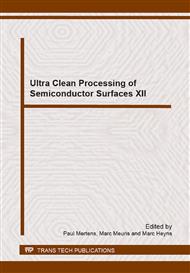p.73
p.78
p.81
p.85
p.89
p.93
p.97
p.101
p.105
Watermark Formation on Bare Silicon: Impact of Illumination and Substrate Doping
Abstract:
The wet cleaning process plays an important role in advanced semiconductor industry. Particularly when bare silicon areas are exposed, wafer drying can result in undesired watermark (WM) residues on the surface [1-2]. In principle there are three components effecting the formation, shape and size of WM. 1) composition of the ambient like oxygen concentration, relative humidity and temperature affect WM formation [3]. 2) liquid: factors such as pH and the amount of dissolved species inside the liquid influence the WM composition. 3) substrate: for silicon for instance: surface passivation is important for WM formation [2]. WMs are composed of silica that is formed during the drying process by oxidation of the silicon surface [1]. Therefore when studying WM formation it is important to understand the mechanism (s) of silicon oxidation and the dissolution.
Info:
Periodical:
Pages:
89-92
Citation:
Online since:
September 2014
Keywords:
Price:
Сopyright:
© 2015 Trans Tech Publications Ltd. All Rights Reserved
Share:
Citation:


